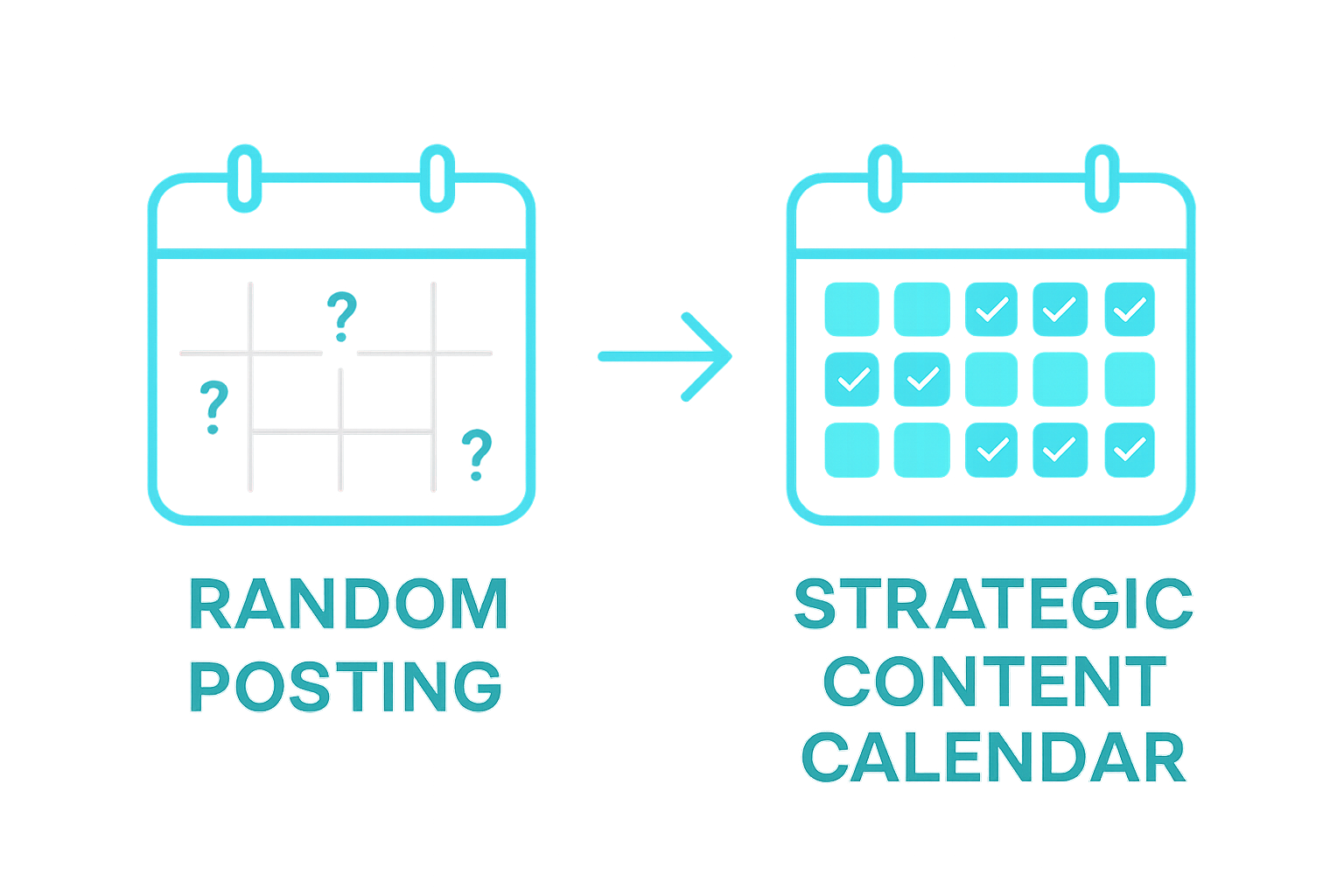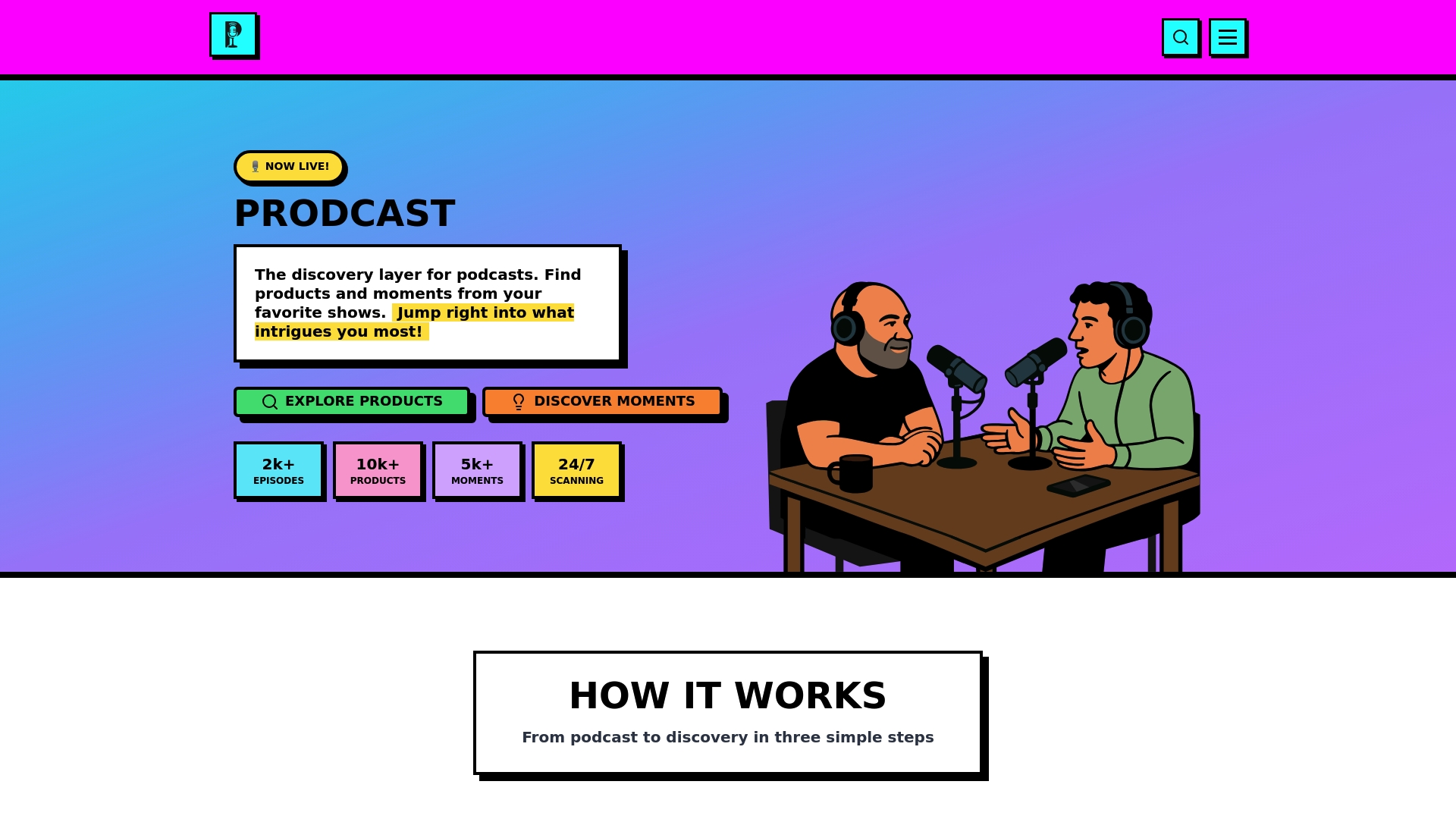Build a Content Calendar for Your Brand Success in 2025

Creating a content calendar sounds simple and routine, mostly just lists and dates. But content success depends on much more than just staying organized. Brands that set clear SMART goals see up to 376 percent higher results in audience engagement and measurable outcomes. Most teams actually get stuck before the calendar even begins and the biggest mistakes happen before anyone even picks a date. The real secret is that your calendar is worthless until your strategy is alive and working for your brand now.
Table of Contents
- Step 1: Identify Your Content Goals
- Step 2: Research Your Target Audience
- Step 3: Choose Your Content Types And Themes
- Step 4: Set A Publishing Schedule
- Step 5: Organize Your Content In A Calendar
- Step 6: Review And Adjust As Necessary
Quick Summary
| Key Point | Explanation |
|---|---|
| 1. Set Clear Content Goals | Define specific, measurable goals that align with your brand’s mission to guide content creation. |
| 2. Understand Your Audience | Conduct thorough research to create detailed audience profiles, focusing on their preferences and needs. |
| 3. Choose Appropriate Content Types | Align content types and themes with audience interests to maximize engagement and relevance. |
| 4. Establish a Consistent Publishing Schedule | Create a regular cadence for content release that resonates with audience consumption patterns. |
| 5. Review and Adjust Quarterly | Regularly assess content performance and audience feedback to refine and improve your strategy. |
Step 1: Identify Your Content Goals
Building a content calendar begins with establishing clear and strategic goals that will guide your entire content creation process. Your content goals serve as the foundational roadmap, determining not just what you create, but how you will measure success and align your efforts with broader brand objectives.
Start by conducting a comprehensive assessment of your brand’s current communication needs and long term strategic vision. This means looking beyond simple metrics like follower count and diving deep into meaningful outcomes that drive real business value. Effective content goals should connect directly to your organization’s core mission and provide tangible, measurable results.

Consider the multiple dimensions of your content strategy. Are you aiming to increase brand awareness, generate leads, establish thought leadership, or drive direct sales? Each goal requires a different approach and set of tactics. For podcast and digital content creators, this might mean crafting goals around listener engagement, audience growth, affiliate marketing conversions, or building a community around your brand.
To crystallize your goals, utilize the SMART framework: Specific, Measurable, Achievable, Relevant, and Time-bound. Instead of a vague objective like “grow our audience,” develop a precise target such as “increase podcast listener base by 25% within six months by producing weekly episodes featuring industry experts and leveraging our guide on podcast strategy”.
Key verification indicators that you have successfully identified your content goals include:
Below is a checklist table to help you verify that you have successfully identified effective content goals before building your content calendar.
| Verification Step | Description |
|---|---|
| Written Content Objectives | Clear, documented statements outlining each content goal. |
| Quantifiable Metrics | Specific, measurable indicators attached to each content objective. |
| Organizational Alignment | Goals directly support the broader brand mission and strategy. |
| Stakeholder Consensus | Agreement from all key team members and decision makers on defined goals. |
| Scheduled Reviews | Plan to revisit and update goals quarterly to remain relevant and effective. |
- Clear, written statements of each content objective
- Quantifiable metrics tied to each goal
- Alignment with broader organizational strategies
- Consensus among key stakeholders about the defined goals
Remember that content goals are not static documents. Plan to review and adjust them quarterly, ensuring they remain responsive to changing market dynamics, audience preferences, and your brand’s evolving priorities. Your content calendar is a living strategy that should flex and adapt as your brand grows and learns from its experiences.
Step 2: Research Your Target Audience
Researching your target audience is a critical step in building a content calendar that truly resonates and drives engagement. This process goes far beyond basic demographic information, requiring a deep, nuanced understanding of your audience’s motivations, behaviors, challenges, and content consumption preferences.
Effective audience research transforms generic content into targeted, compelling communication that speaks directly to your listeners’ needs and interests. Begin by leveraging multiple research methods to create a comprehensive audience profile. Utilize analytics from your podcast platforms, social media insights, survey tools, and direct audience feedback to gather rich, multidimensional data about your listeners.
Dive into the specifics of your audience’s content consumption habits. What podcasts do they currently listen to? What topics generate the most engagement? What times of day are they most likely to consume content? Understanding these patterns allows you to craft a content calendar that meets your audience exactly where they are. For podcast creators and brands looking to expand their reach, consider exploring trending product insights to align your content with current market interests.
Create detailed audience personas that go beyond surface demographics. These personas should include:
- Detailed psychographic information including values, interests, and pain points
- Preferred content formats and consumption channels
- Professional and personal challenges they’re seeking to solve
- Specific goals and aspirations related to your content niche
Remember that audience research is an ongoing process. Plan to revisit and update your audience insights quarterly, tracking shifts in listener preferences, emerging trends, and changes in content consumption behaviors. Your ability to remain adaptive and responsive to your audience’s evolving needs will be the key to maintaining a dynamic and engaging content strategy.
Step 3: Choose Your Content Types and Themes
Selecting the right content types and themes is a strategic process that transforms your content calendar from a basic scheduling tool into a powerful communication framework. This step bridges your audience research with actionable content planning, ensuring that every piece of content you create serves a specific purpose and resonates with your target listeners.
Begin by mapping out the diverse content types that align with your brand’s strengths and audience preferences. For podcast creators and digital brands, this might include long-form interview episodes, quick expert insights, narrative storytelling segments, product review discussions, industry trend analyses, and behind-the-scenes content. The key is creating a balanced mix that provides value while maintaining your unique brand voice and maintaining audience interest.
Consider the strategic themes that will thread through your content calendar. These themes should emerge organically from your audience research, reflecting their interests, challenges, and aspirations. Develop a thematic framework that allows for flexibility while providing a consistent narrative arc across your content. This approach helps create anticipation among your audience and establishes your brand as a thought leader in your specific niche.
Technology and tools can significantly streamline your content type and theme selection process. Leverage podcast analytics, social media insights, and audience feedback platforms to validate your content strategy. Explore trending product insights to identify emerging topics and content opportunities that can keep your calendar fresh and relevant.
Verify the effectiveness of your content types and themes through these key indicators:
- Consistent engagement rates across different content formats
- Positive audience feedback and interaction
- Alignment with original content goals and brand messaging
- Ability to generate meaningful conversations and community building
Remember that your content calendar is a living document. Plan to review and adjust your content types and themes quarterly, remaining agile and responsive to shifts in audience interests and industry trends. The most successful content strategies are those that can evolve while maintaining a core, recognizable brand identity.
Step 4: Set a Publishing Schedule
Establishing a consistent and strategic publishing schedule transforms your content calendar from a static document into a dynamic roadmap for brand engagement. The publishing schedule is the heartbeat of your content strategy, determining how and when your audience will interact with your podcast, brand messaging, and digital content.
Begin by understanding your audience’s content consumption patterns. This means analyzing peak listening times, platform preferences, and the optimal frequency that keeps your audience engaged without overwhelming them. For most podcast creators and digital brands, this typically means finding a sweet spot between maintaining consistent presence and avoiding content fatigue.
Develop a realistic publishing rhythm that aligns with your production capabilities and audience expectations. Some brands might thrive with weekly episodes, while others find success in bi-weekly or monthly deep-dive content. The key is consistency and quality over quantity. Consider your team’s resources, content preparation time, and the complexity of your planned episodes or content pieces.
Utilize digital tools and project management platforms to create a visual and actionable publishing schedule. Explore trending product insights to understand how top creators manage their content calendars and integrate technology into their workflow. Color-coding, automated reminders, and collaborative features can help streamline your content production process.
Verify the effectiveness of your publishing schedule through these critical indicators:
- Consistent content delivery matching predetermined frequency
- Stable or increasing audience engagement rates
- Smooth content production workflow without last-minute rushes
- Positive audience feedback about content timing and regularity
Remember that your publishing schedule is not set in stone. Build flexibility into your calendar, allowing room for timely content, special episodes, or unexpected industry developments. Quarterly reviews and adjustments will help you maintain a dynamic and responsive content strategy that keeps your audience consistently engaged and excited about your brand’s offerings.
Step 5: Organize Your Content in a Calendar
Organizing your content in a structured calendar transforms strategic planning into actionable execution. This step is about creating a visual roadmap that brings your content strategy to life, providing clarity, accountability, and a comprehensive overview of your brand’s communication efforts.
Choose a calendar platform that matches your team’s workflow and complexity. Digital tools like Google Calendar, Trello, Asana, or specialized content management platforms offer robust features for tracking content creation, scheduling, and collaboration. Consider factors like team accessibility, integration capabilities, and visualization options when selecting your primary calendar tool.
Implement a color-coding system that allows quick visual comprehension of your content strategy. Assign different colors to represent various content types, themes, or production stages. For instance, blue might indicate podcast interviews, green for product review episodes, and yellow for behind-the-scenes content. This visual approach helps team members quickly understand the content mix and identify potential gaps or imbalances in your strategy.
Explore trending product insights to understand how successful brands structure their content calendars and incorporate emerging trends. Effective calendar organization goes beyond simple scheduling; it’s about creating a dynamic tool that supports your brand’s storytelling and audience engagement objectives.
Ensure your content calendar includes these critical elements:
The following table summarizes the core elements your content calendar should include to ensure it covers all the strategic and practical details needed for execution.
| Calendar Element | Purpose |
|---|---|
| Publication Dates/Times | Schedule when each content piece will be published |
| Content Type/Theme | Identify the format and central topic for each entry |
| Author/Creator | Assign responsibility to team members |
| Target Audience Segment | Specify which audience group the content is designed to reach |
| Promotional Channels | Outline distribution platforms and marketing strategies |
| Keywords/SEO Considerations | Highlight important search terms for optimization |
- Specific publication dates and times
- Content type and theme
- Primary author or content creator
- Target audience segment
- Promotional channels and strategies
- Relevant keywords or SEO considerations
Remember that your content calendar is a living document. Schedule quarterly review sessions to assess its effectiveness, making adjustments based on performance metrics, audience feedback, and evolving brand objectives. The most successful content strategies remain flexible while maintaining a clear strategic vision.

Step 6: Review and Adjust as Necessary
Reviewing and adjusting your content calendar is not just a maintenance task but a strategic process that ensures your brand remains responsive, relevant, and aligned with audience expectations. This final step transforms your content strategy from a static plan into a dynamic, evolving communication framework that can adapt to changing market conditions and audience preferences.
Establish a systematic review process that goes beyond surface-level metrics. Dive deep into analytics, examining not just engagement numbers but the qualitative aspects of audience interaction. Look for patterns in listener feedback, content performance, and emerging trends that might signal a need for strategic pivots. This means analyzing download rates, listener retention, social media interactions, and direct audience comments to gain a comprehensive understanding of your content’s impact.
Schedule quarterly review sessions where you critically evaluate your content calendar against your original goals. Be prepared to make bold adjustments that prioritize audience value over rigid adherence to initial plans. Sometimes this might mean completely restructuring your content themes, experimenting with new formats, or reallocating resources to more promising content streams. Explore trending product insights to understand how successful brands maintain agility in their content strategies.
Utilize a comprehensive set of evaluation criteria during your review process:
- Alignment with original content goals and brand mission
- Audience engagement and growth metrics
- Content production efficiency and resource allocation
- Relevance of themes and topics to target audience
- Competitive landscape and industry trends
Remember that successful content strategy is about continuous learning and adaptation. Approach each review as an opportunity for innovation, not just correction. Maintain a growth mindset that views every piece of content as a learning experience, helping you refine your approach and develop a more nuanced understanding of your audience’s evolving needs and preferences.
Turn Your Content Calendar Into Real Sales and Deeper Engagement
You spend hours shaping your content calendar, setting goals, mapping themes, and fine-tuning your publishing schedule. But how do you make sure your hard work actually delivers value and measurable results? For many creators and brands, the biggest challenge is driving tangible outcomes from all that planning. If you are eager to turn passive listeners into active customers and build a proven growth cycle for your brand, the next step is clear.

Ready to stop guessing and start generating results? Prodcast takes your audio content strategy to the next level. Our advanced AI platform scans podcast episodes, pinpoints specific product mentions, and instantly connects listeners with the right products using Amazon affiliate integration. No more missed opportunities or ideas lost in the noise. Whether you want to showcase your own products to a targeted audience or tap into premium features for a custom content experience, now is the time to transform your calendar from a plan into action. Join Prodcast and see how your content can directly fuel sales, discovery, and true brand success.
Frequently Asked Questions
What are the key steps to build a content calendar for my brand?
Building a content calendar involves identifying your content goals, researching your target audience, choosing content types and themes, setting a publishing schedule, organizing your content visually, and regularly reviewing and adjusting your calendar as necessary.
How can I identify effective content goals for my brand?
Effective content goals should be specific, measurable, achievable, relevant, and time-bound (SMART). They should align with your brand’s core mission and focus on achieving meaningful outcomes, such as increasing brand awareness or generating leads.
What strategies can I use to research my target audience?
To research your target audience, use analytics from your podcast platforms, social media insights, surveys, and direct audience feedback. Create detailed audience personas that include psychographics, preferred content formats, and their specific challenges and aspirations.
How often should I review and adjust my content calendar?
You should plan to review and adjust your content calendar quarterly. This allows you to remain responsive to changing market dynamics, audience preferences, and your brand’s evolving priorities, ensuring your content strategy stays relevant and effective.